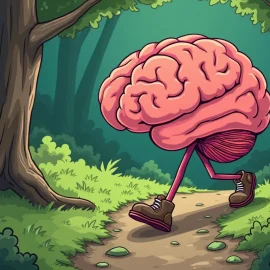

This article is an excerpt from the Shortform book guide to "Stealing Fire" by Steven Kotler and Jamie Wheal. Shortform has the world's best summaries and analyses of books you should be reading.
Like this article? Sign up for a free trial here.
What’s the book Stealing Fire about? What are peak states of consciousness? How do they help us reach true fulfillment?
Stealing Fire is a book co-written by Stephen Kotler and Jamie Wheal that explores the modern revolution in our understanding of peak states of consciousness, which they call “ecstasis.” These states are typically found through deep meditative experiences, psychedelic exploration, and extreme sports.
Read on for a brief overview of the Stealing Fire book, including Kotler and Wheal’s key takeaways.
Stealing Fire Book Overview
The Stealing Fire book authors, Stephen Kotler and Jamie Wheal, tell the story of a modern revolution in our understanding of peak states of consciousness. These states, which the authors call “ecstasis” (we’ll call them peak states), are typically found through deep meditative experience, psychedelic exploration, extreme sports, and more. The authors argue that experiencing peak states can catalyze significant personal transformation, often through spiritual fulfillment, deep creative flow, or peak athletic performance.
For much of human history, various cultures have explored and experienced these states. Not until recently, though, have we had the tools to understand them. According to the authors, various scientific advances now enable us to clear the fog around these experiences long held to be mystical and unscientific. We’ve begun to establish evidence-based accounts of peak states, and the authors suggest that as a result, more people will be able to access the profound benefits of peak states to vastly improve their lives.
Kotler and Wheal are best-selling authors as well as the co-founders of the Flow Genome Project, an organization dedicated to researching peak states. They train high-performing groups including US Navy SEALs, Fortune 500 CEOs, and Olympic athletes.
Peak States Today and in the Past
In their book Stealing Fire, the authors define peak states and contextualize them in history. Namely, they argue that today’s ecstatic revolution is the most recent development in an age-old historical pattern. We’ll discuss how this development increases the potential of peak states to expand and improve our lives.
What Are Peak States?
The Stealing Fire book defines peak states (or “ecstasis”) as a specific set of altered states of consciousness. “Altered states of consciousness” means a nonstandard subjective experience—think inebriation versus sobriety.
While altered states include any state other than normal consciousness, peak states occur at the “high end” of possible subjective experiences. In these states, you might encounter novel sensations or visual stimuli, experience heightened creativity, or gain access to seemingly mystical awareness.
The authors specify a set of four peak states. These states share several features, including nonstandard perceptions, intense or unusual emotions, and shifts in your sense of self, time, and reality.
Peak State #1: Flow—The state of heightened awareness and “in-tune-ness” associated with master-level performance of a skill. According to the authors, athletes, chess masters, craftspeople, martial artists, and others experience flow when performing at their peaks.
Peak State #2: Group flow—The state of enhanced social cohesion and awareness that occurs when groups of people fully immerse themselves in shared experience (common at concerts, raves, and other festival environments.)
Peak State #3: Psychedelic experience—The states of expanded consciousness that occur following consumption of a psychoactive substance such as psilocybin mushrooms (“shrooms”) or lysergic acid diethylamide (LSD).
Peak State #4: Mystical experience or enlightenment—The various religious or spiritual states that the authors say can occur as a result of deep meditation, spiritual cultivation, or a near-death experience.
The Scientific Advancements Pushing This Trend
Now that we’ve explained what peak states are and why they matter, we’ll explain how modern science has begun to demystify them, and we’ll detail the four broad trends that constitute a peak state revolution, according to the authors. Specifically, we’ll discuss advances across the fields of psychology, neuroscience, pharmacology, and biotechnology that reflect this increased interest in peak states.
How Modern Science Demystifies Peak States
In their book Stealing Fire, Kotler and Wheal claim that for most of history, peak states have been shrouded in mystery for at least two reasons. First, we lacked the tools to study them with scientific rigor—not until recently have we had the tools to, say, study the brains of experienced meditators or psychedelic users. Second, the authors argue, the longstanding divide between doubtful empiricists (who favor cold, hard facts) and the faithful (who believe but lack evidence) has hindered serious study of peak states. In other words, most serious scientists weren’t interested in such studies, and research done by believers often lacked the rigor demanded by established scientific standards.
However, the authors argue, we now have sufficiently advanced technology as well as cultural conditions conducive to serious study of peak states. Researchers are actively exploring these regions of subjective experience, gathering data, and working out empirical explanations for peak states. It’s now broadly accepted that peak states are real—and we’re discovering just what they are, how they work, and how we can benefit from them.
Advancements in Psychology
First, the authors argue that the culture of modern psychological study has shifted to embrace pragmatic, open-minded exploration of human potential. Whereas psychologists used to focus on illness and often pathologized the human mind, there are more researchers today who choose to explore topics such as positivity, adult development, growth, well-being, and mindfulness.
According to the authors’ book Stealing Fire, this cultural shift began several decades ago. The epicenter of the change, they argue, was the Esalen Institute in the 1960s. At this countercultural California research and retreat center, psychologists, philosophers, and spiritual seekers gathered to explore various methods of personal, spiritual, and emotional growth, drawing from Buddhistic ideas as well as Western theories of adult development. This eclectic gathering of open-minded seekers gave rise to modern Western culture’s appetite for personal transformation and growth.
More recently, researchers have found that peak states can both heal psychological traumas and facilitate positive personal growth:
1. Peak state experiences can heal the effects of trauma—The authors describe studies that found that peak states—such as those reached through flow, near-death experiences, or the substance MDMA—can heal or reduce the effects of trauma (such as flashbacks or deeply-set fears). Specifically, peak states can help us to see our traumas from new perspectives, process deeply buried emotions, and break free from cycles of reliving those traumas. These changes last for months or longer and outperform typical drug-based remediations.
2. Peak experiences can accelerate personal development—Researchers of adult development found that people who have had more peak experiences than average are often more empathetic, act more ethically, and are more productive. Based on this, the authors argue that regular peak experiences—whether from psychedelics or yoga or elsewise—accelerate your growth.
Advancements in Neuroscience
Alongside these advances in psychology, neuroscientists have developed brain scanning technologies that enable them to decode peak states. With these technologies, the authors say, researchers have begun to build evidence-based models of various peak states. Altogether, this gives us a clearer picture of the range of possible subjective experiences.
A concrete example: Neuroscience researchers have studied the brains of people who can reliably access peak states, such as Tibetan monks, and identified the neurophysiological conditions that correlate with those states. Data of this kind allows researchers to distinguish between normal consciousness and peak states by identifying the characteristic markers of each:
- Regular consciousness, the authors say, involves high activity in the prefrontal cortex, beta range brainwaves, and the consistent presence of norepinephrine and cortisol (two stress hormones).
- Peak states involve a shift in activity in the prefrontal cortex—some regions rev up while others shut down—as well as slower alpha and theta brainwaves and a different balance of neurochemicals including dopamine, endorphins, and serotonin.
Altogether, these changes function to dissolve your sense of self, heighten feelings of existential well-being, and expand your perceptual experience. And, the authors argue, we can use our knowledge of how these states work to intentionally reproduce them and improve our lives.
Advancements in Pharmacology
With neuroscience research revealing how the brain works during peak state experiences, it’s now possible to precisely access and reproduce those states. According to the authors, one of the best ways to do so is with intoxicating substances such as LSD, psilocybin, and other psychoactive molecules. Further, they argue that recent advances in chemistry and pharmacology will soon make it possible to produce these substances at home and share their recipes over the internet.
For most of history, however, people only had access to the substances that both grew in their locale and were culturally sanctioned. Crucially, the authors explain, this limited the range of peak experiences people could have. Today, though, we have access to a much wider range of substances. Since the mid-twentieth century, independent chemists and pharmacologists have developed recipes and written books to enable people to create psychoactive substances at home. Further, they fought to open-source this knowledge and resisted government efforts to make psychedelics illegal.
As a result, today anyone can go online and research how to synthesize LSD or grow psilocybin mushrooms right in their living rooms. To make things even easier, advances in 3D printing and synthetic biology have begun to produce molecules from simple household ingredients such as vegetable oil and starch. The authors argue that you’ll soon be able to produce various psychedelic molecules at home with nothing more than a 3D printer and a recipe downloaded from the internet.
Advancements in Technology
Despite easier access, some routes to peak states—namely, psychedelics and extreme sports (such as skiing, freeclimbing, big-wave surfing, and skydiving)—remain risky, and people have lost their minds and their lives pursuing the peak states they create. However, the authors argue, new technologies are making peak states safer and easier to access for larger and larger groups of people.
To reduce the danger of peak states found through, for instance, flying down alpine slopes on racing skis, entrepreneurs have begun to create safer alternatives that simulate the same experience. For example, indoor skydiving tunnels mimic the high of jumping from an airplane. In addition, entrepreneurs, including the authors, have begun to create “gyms” outfitted with biofeedback tech and other apparatuses designed to induce flow in a safe manner. With technologies such as giant swings, sensory deprivation tanks, and heartbeat and brainwave monitors, people can safely and reliably find peak states.
Peak States in Practice: Risks, Rewards, and How-Tos
In their book Stealing Fire, Kotler and Wheal argue that responsible explorers of peak states need to understand the risks, rewards, and ground rules of exploration before diving in. We’ll start with the four main risks: extreme ego inflation, conflating peak insights with practical success, getting addicted to the highs, and completely losing yourself in the experience.
Risk #1: Extreme ego inflation—Peak experiences, the authors say, can dissolve your sense of self and facilitate powerful insights that dangerously inflate the ego—for instance, sometimes people come back thinking they’re the second coming of Christ. To avoid losing yourself in what can seem like divine revelation, remember that your experience isn’t the end-all-be-all and take it with a grain of salt.
Risk #2: Time frustration—Peak states distort your sense of time, so it’s easy to forget that, in normal life, it takes time to deliver on the brilliant insights you find. To avoid getting frustrated by this, the authors recommend remembering that you’ll need to work to turn your ideas into realities.
Risk #3: Addiction—Peak states can feel incredible—specifically, the authors caution that sensations of great ease and joy can become addictive. Some people die chasing these states through extreme sports or lose their minds on psychedelics. The authors recommend remembering that there are no highs without lows, and they say to embrace the grit and grind of everyday life.
Risk #4: Over-immersion—According to the authors, the richness and depth of peak experiences lure some people into going too deep, too fast. Some extreme sports athletes die by pushing too far, too fast; some psychedelic explorers lose their minds doing the same. To avoid this fate, remember that the experience means nothing if you come back broken or not at all. So take it slow, and don’t discount the value of sobriety.

———End of Preview———
Like what you just read? Read the rest of the world's best book summary and analysis of Steven Kotler and Jamie Wheal's "Stealing Fire" at Shortform.
Here's what you'll find in our full Stealing Fire summary:
- A modern revolution in the understanding of peak states of consciousness
- The key benefits of accessing peak states
- How some are turning to LSD and other substances to reach a peak state






